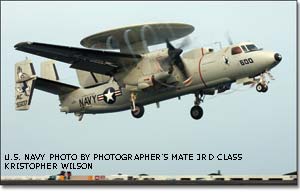| Fast work for network
 Northrop Grumman researchers said they've shown that a communications
network that lets different digital networks interact can be set up and
working in a matter of months. Northrop Grumman researchers said they've shown that a communications
network that lets different digital networks interact can be set up and
working in a matter of months.
A recent Aviation Week & Space Technology article detailed
the latest of Northrop Grumman's experimental, network-centric-warfare
tests. In this test scenario, researchers linked a collection of ground
forces, aircraft and ship-based sensors to track down, identify and bomb
a team of "terrorists" smuggling missiles into the United States.
FULL STORY >>

Good time seen for satellite makers
The recent downturn in the worldwide satellite market is over, according
to an industry report released last month.
Global government and commercial satellite sales should reach $158 billion
by 2010, up 53 percent from the $103 billion in 2004, according to the
report "2005 State of the Space Industry."
FULL STORY >>

IN BRIEF
Lockheed Martin to buy U.K. firm
Lockheed Martin's purchase last month of a British firm that develops
weapons systems and military communications equipment gives the U.S. company
an additional foothold in British defense contracting.
Lockheed's subsidiary in Britain will buy Insys Ltd., a firm that has
done work on a wide range of programs for the U.K. Ministry of Defence
(MoD).
FULL STORY >>

Airbus to boost parts sourcing in China,
inks r&d pact in Russia
Airbus said it wants to construct more airplane parts in China to help
spur sales in that nation, which is one of the fastest-growing commercial
jetliner markets.
By increasing the sourcing of parts—especially for the A380, its
new superjumbo jet—Airbus hopes to better integrate the mainland
market into its supply chain, an AFX Asia news service report said.
FULL STORY >>

U.S. aerospace employment continues
ascent
Employment in the U.S. aerospace industry, which began rebounding last
year after hitting a 50-year low, has grown by 11,100 jobs this year,
the Aerospace Industries Association said last month. The AIA said employment
now stands at 618,400 versus 607,300 in December 2004, and the outlook
for the rest of this year is upbeat.
Aerospace employment had been falling steadily since the early 1990s
as a result of the end of the Cold War and other factors. It hit a 50-year
low of 579,700 in February 2004, but then started a sustained rebound
that added 27,400 jobs by the end of the year, the AIA said.
"It's encouraging to see last year's employment increases marked
the beginning of what is hopefully a long-term trend," John Douglass,
president and CEO of AIA, said in a statement. "This once again proves
how we are an important economic engine for the United States."
|

